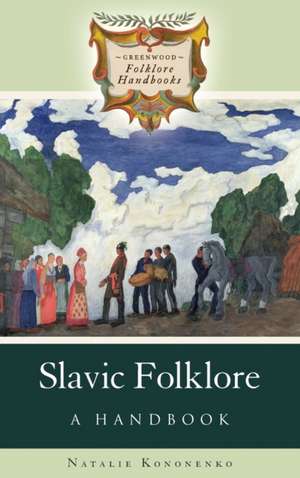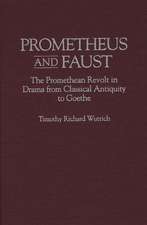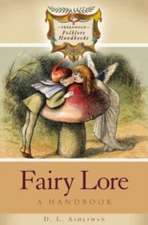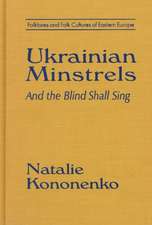Slavic Folklore: A Handbook: Greenwood Folklore Handbooks
Autor Natalie Kononenkoen Limba Engleză Hardback – 29 sep 2007 – vârsta până la 17 ani
Din seria Greenwood Folklore Handbooks
- 43%
 Preț: 282.86 lei
Preț: 282.86 lei - 42%
 Preț: 269.87 lei
Preț: 269.87 lei - 42%
 Preț: 226.31 lei
Preț: 226.31 lei - 42%
 Preț: 263.89 lei
Preț: 263.89 lei - 42%
 Preț: 260.67 lei
Preț: 260.67 lei - 42%
 Preț: 259.43 lei
Preț: 259.43 lei - 42%
 Preț: 250.49 lei
Preț: 250.49 lei - 42%
 Preț: 262.27 lei
Preț: 262.27 lei - 42%
 Preț: 254.13 lei
Preț: 254.13 lei - 42%
 Preț: 261.41 lei
Preț: 261.41 lei - 42%
 Preț: 260.76 lei
Preț: 260.76 lei - 42%
 Preț: 259.61 lei
Preț: 259.61 lei - 42%
 Preț: 225.08 lei
Preț: 225.08 lei - 42%
 Preț: 259.61 lei
Preț: 259.61 lei - 42%
 Preț: 259.33 lei
Preț: 259.33 lei
Preț: 259.52 lei
Preț vechi: 450.95 lei
-42% Nou
Puncte Express: 389
Preț estimativ în valută:
49.66€ • 51.98$ • 41.33£
49.66€ • 51.98$ • 41.33£
Carte tipărită la comandă
Livrare economică 31 martie-14 aprilie
Preluare comenzi: 021 569.72.76
Specificații
ISBN-13: 9780313336102
ISBN-10: 0313336105
Pagini: 232
Dimensiuni: 156 x 235 x 21 mm
Greutate: 0.46 kg
Editura: Bloomsbury Publishing
Colecția Greenwood
Seria Greenwood Folklore Handbooks
Locul publicării:New York, United States
ISBN-10: 0313336105
Pagini: 232
Dimensiuni: 156 x 235 x 21 mm
Greutate: 0.46 kg
Editura: Bloomsbury Publishing
Colecția Greenwood
Seria Greenwood Folklore Handbooks
Locul publicării:New York, United States
Notă biografică
Natalie Kononenko holds the Kule Chair of Ukranian Ethnography at the University of Alberta. Her numerous publications include Ukranian Minstrels (1998), The Magic Egg and Other Tales from the Ukraine (Libraries Unlimited, 1997), and The Turkish Minstrel Tale Tradition (1990).
Cuprins
PrefaceAcknowledgmentsNote on TransliterationNote on Tale Type Numbersone IntroductionTwo Definitions and ClassificationsThree Examples and TextsFour Scholarship and ApproachesFive ContextsGlossaryBibliographyWeb ResourcesIndex
Recenzii
Kononenko's insightful commentaries are probably the best feature of this first-ever English-language book on Slavic folklore. Chapter 2 is especially valuable for its survey and thought-provoking explanations of folklore genres, rituals, and architecture (examples are included). Other chapters offer stimulating discussions of folklore in the Slavic cultures; the author includes Ukrainian and Polish folklore materials from the US and Canada to demonstrate that Slavic folklore need not be an exotic subject. One chapter, Examples and Texts, provides the student with materials for papers, a thoughtful, time-saving gesture. Kononenko concludes with a useful chapter on Web resources..this is a valuable addition to the literature on Slavic literature and culture. Recommended. Lower-division undergraduates through faculty.
Although Natalie Kononenko touches on other aspects of Slavic folklore the major part of this book is given over to narrative. There are plenty of examples showing the different types of stories and story poems with information relating to the time these were recorded in written form and who recorded and preserved them. Natalie then goes on to explore the history of folklore research in the area, examining the social fashions and political trends that affected such scholarship over the years.
A meticulous study of its subject matter rather than a fairu-tale book of stories. Accessible to general readers, Slavic Folklore discusses the definitions and classifications of Slavic mythography, various scholary approaches and context for understanding these enduring works, and a handful of sample texts..A glossary, bibliography, and index round out this welcome addition to folklore and mythology studies shelves, as well as college library reference shelves.
Natalie Kononenko's recent volume in the Greenwood Folklore Handbooks series is a most welcome addition to the ever-growing body of scholarship on Slavic folklore in English. . . All in all this is a most useful work for the beginning student, especially one who wants to gain a good overview of Russian and Ukranian folklore and folklore scholarship.
Natalie Kononenko's Slavic Folklore: A Handbook is suitable for use in survey courses as well as for in-depth folklore studies. The volume is especially strong in genres like memorates, fabulates and material culture, often less familiar than folktales to non-specialists. It includes a helpful note on Aarne-Thompson Tale Type numbers, definitions and classifications of folk genres, examples and texts, an overview of major scholarly works and approaches, informative bibliographies at each section's end, and other scholarly apparatus, including a particularly valuable glossary of terms and genres. Numerous photographs and illustrations, many taken by the author, enliven the pages.
. . . a very beneficial publication for western readers and scholars, and also for Slavic scholars and students interested in issues of folkloristics. It will be accessible to a wide variety of readers interested in Slavic culture and folklore. . . . Slavic Folklore is a carefully structured handbook that slowly leads readers from a general understanding of Slavs as an ethnic group to a clear description of specific national folk genres and practices within the contemporary Slavic world . . . . Reading this book, one is struck by how nearly perfectly it serves in its main role. It is a textbook, and for students of Slavic folklife and folk culture it is an invaluable source of knowledge. It performs a service to western readers, satisfying their interest in various forms of Slavic folklore, and it may also serve as a first step toward cross-pollination of folklore studies.
Although Natalie Kononenko touches on other aspects of Slavic folklore the major part of this book is given over to narrative. There are plenty of examples showing the different types of stories and story poems with information relating to the time these were recorded in written form and who recorded and preserved them. Natalie then goes on to explore the history of folklore research in the area, examining the social fashions and political trends that affected such scholarship over the years.
A meticulous study of its subject matter rather than a fairu-tale book of stories. Accessible to general readers, Slavic Folklore discusses the definitions and classifications of Slavic mythography, various scholary approaches and context for understanding these enduring works, and a handful of sample texts..A glossary, bibliography, and index round out this welcome addition to folklore and mythology studies shelves, as well as college library reference shelves.
Natalie Kononenko's recent volume in the Greenwood Folklore Handbooks series is a most welcome addition to the ever-growing body of scholarship on Slavic folklore in English. . . All in all this is a most useful work for the beginning student, especially one who wants to gain a good overview of Russian and Ukranian folklore and folklore scholarship.
Natalie Kononenko's Slavic Folklore: A Handbook is suitable for use in survey courses as well as for in-depth folklore studies. The volume is especially strong in genres like memorates, fabulates and material culture, often less familiar than folktales to non-specialists. It includes a helpful note on Aarne-Thompson Tale Type numbers, definitions and classifications of folk genres, examples and texts, an overview of major scholarly works and approaches, informative bibliographies at each section's end, and other scholarly apparatus, including a particularly valuable glossary of terms and genres. Numerous photographs and illustrations, many taken by the author, enliven the pages.
. . . a very beneficial publication for western readers and scholars, and also for Slavic scholars and students interested in issues of folkloristics. It will be accessible to a wide variety of readers interested in Slavic culture and folklore. . . . Slavic Folklore is a carefully structured handbook that slowly leads readers from a general understanding of Slavs as an ethnic group to a clear description of specific national folk genres and practices within the contemporary Slavic world . . . . Reading this book, one is struck by how nearly perfectly it serves in its main role. It is a textbook, and for students of Slavic folklife and folk culture it is an invaluable source of knowledge. It performs a service to western readers, satisfying their interest in various forms of Slavic folklore, and it may also serve as a first step toward cross-pollination of folklore studies.


















